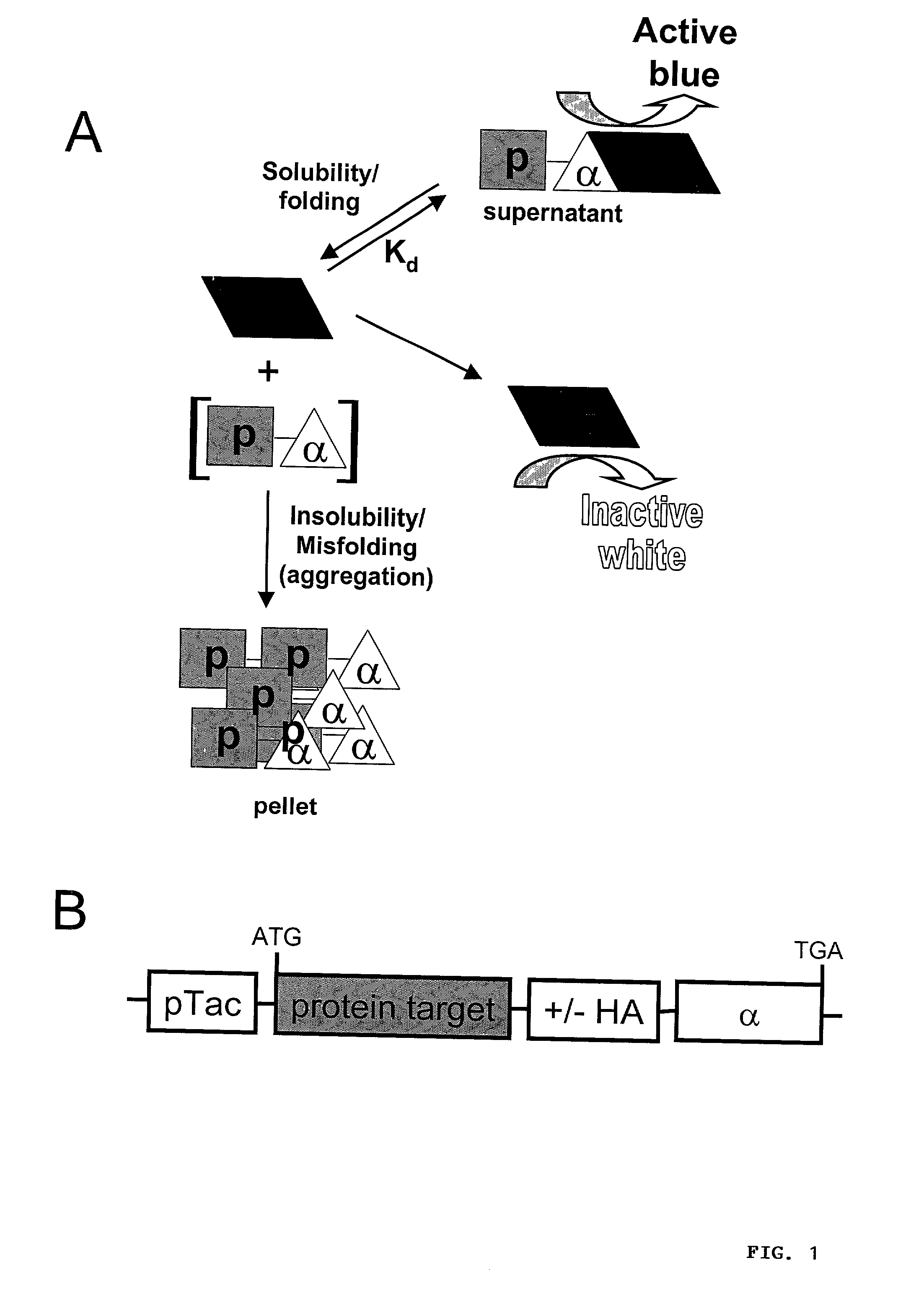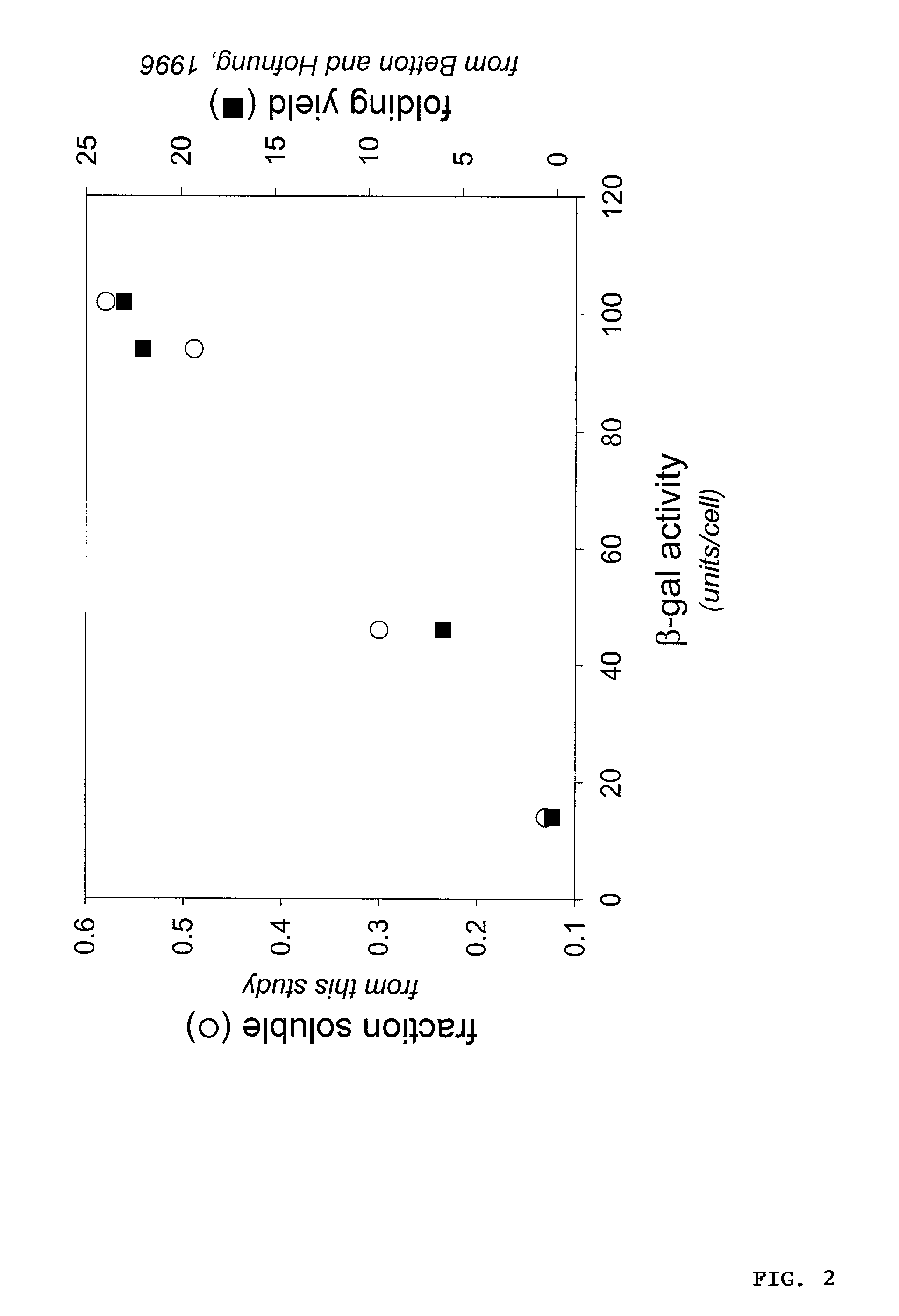Protein/solubility folding assessed by structural complementation
a structural complementation and protein technology, applied in the field of biochemistry, cellular biology and molecular biology, can solve the problems of inefficient improvement of solubility, many important target proteins are not efficiently expressed in soluble form, and the existing assays for protein expression in soluble form are tedious
- Summary
- Abstract
- Description
- Claims
- Application Information
AI Technical Summary
Problems solved by technology
Method used
Image
Examples
first embodiment
[0230] There are three primary applications for the invention: screening of proteins for suitability in recombinant polypeptide production, screening for mutants or domain boundaries with altered folding and / or solubility profiles (e.g., diagnosis of disease), and screening for drugs that modulate protein folding and / or solubility. In the first embodiment, the method includes the steps of:
[0231] a) providing an expression construct comprising (i) a gene encoding a fusion protein, said fusion protein comprising a protein of interest fused to a first segment of a marker protein, wherein said first segment does not affect the folding or solubility of the protein of interest, or affects it only is a systematic (i.e., predictable and repeatable) manner and (ii) a promoter active in said host cell and operably linked to said gene;
[0232] b) expressing said fusion protein in a host cell that also expresses a second segment of said marker protein, wherein said second segment is capable of st...
example 1
Materials and Methods
[0269] Antibodies, Chemicals and Expression Vectors
[0270] Monoclonal mouse anti-HA and polyclonal sheep anti-MBP antibodies were purchased from BabCO (Richmond, Calif.). Horseradish peroxidase-conjugated (HRP) secondary antibodies were from Jackson ImmunoResearch Laboratories (West Grove, Pa.). Isopropyl-.beta.-D-thiogal-actopyranoside (IPTG) and 5-bromo-4-chloro-3-indolyl-.beta.-D-galactopyran-oside (X-gal) were from Boehringer Mannheim (Indianapolis, Ind.). O-nitrophenyl-.beta.-D-galactopyranoside (ONPG) was purchased from Sigma (St. Louis, Mo.). The expression vector pMAL-c2x, coding for an MBP-.alpha. fusion, was from New England Biolabs (Beverly, Mass.). A plasmid containing cDNA for the LivF protein of M. jannaschii (MJ1267) was obtained from the American Type Culture Collection. Plasmid pAPP770 containing cDNA for the Alzheimer's precursor protein (APP) was the generous gift of Dr. J. Herz, Dept. Molecular Genetics, UT Southwestern, Dallas, Tex. Plasmid p...
example 2
Results
[0289] In order to test the ability of .alpha.-fragment chimeras to complement the .omega.-fragment of .beta.-gal and report target protein solubility by producting active .beta.-gal, model polypeptides were fused to the N-terminus of the .alpha.-fragment in an inducible bacterial expression plasmid (FIG. 1B). Initial experiments focused on the maltose binding protein (MBP) of E. coli. MBP is normally secreted into the periplasm of E. coil, however, the construct used in the present study lacks the required leader sequence and therefore, folds in the cytoplasm where the .omega.-fragment is located.
[0290] To assess the relative abilities of the expressed .alpha.-fusion proteins to complement .beta.-gal activity in vivo, E. coli harboring the fusion expression constructs were plated on IPTG / X-gal indicator plates and the development of blue color in resulting colonies was monitored. pUC19-transformed DH5.alpha. E. coli, which express a 54 residue .alpha.-fragment (residues 6-59...
PUM
| Property | Measurement | Unit |
|---|---|---|
| Volume | aaaaa | aaaaa |
| Volume | aaaaa | aaaaa |
| Volume | aaaaa | aaaaa |
Abstract
Description
Claims
Application Information
 Login to View More
Login to View More - R&D
- Intellectual Property
- Life Sciences
- Materials
- Tech Scout
- Unparalleled Data Quality
- Higher Quality Content
- 60% Fewer Hallucinations
Browse by: Latest US Patents, China's latest patents, Technical Efficacy Thesaurus, Application Domain, Technology Topic, Popular Technical Reports.
© 2025 PatSnap. All rights reserved.Legal|Privacy policy|Modern Slavery Act Transparency Statement|Sitemap|About US| Contact US: help@patsnap.com


